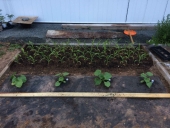
 13
13




New location. Zone 6b, acid soil, 30+ inches of water per year.
https://growingmodernlandraces.thinkific.com/?ref=b1de16
Growingmodernlandraces.com affiliate




Idle dreamer
 1
1




Mediterranean climate, hugel trenches, fabulous clay soil high in nutrients, self-watering containers with hugel layers, keyhole composting with low hugel raised beds, thick Back to Eden Wood chips mulch (distinguished from Bark chips), using as many native plants as possible....all drought tolerant.
 1
1




Cristo Balete wrote:Lauren, this is great information. And it's good to embrace where we are, the soil we have, and the conditions we are given.
Something I learned from Permaculture is to use extra thick mulch, like 6 inches that will shrink down to 4" and maintain that thickness.
For perennials and tomatoes it is good to get the water to go straight down, get it as deep as possible, then it is "stored" and the roots will go down after it. But I see you are noticing that shallow watering everywhere is working for the squash.
Are you using manure?
New location. Zone 6b, acid soil, 30+ inches of water per year.
https://growingmodernlandraces.thinkific.com/?ref=b1de16
Growingmodernlandraces.com affiliate








Sun is a huge factor! I live beside a huge cedar and fir forest and I'm constantly watching exactly where the sun is at what time of the year. Many things that local friends can grow just don't get enough sun on my land, so I have to choose carefully what to plant. That said, east sun is particularly helpful, and west sun can cause overheating and worse drying out, at least in my ecosystem. Some plants are more tolerant of that west sun and more appreciative of the heat. Your observation of your plants is just as critical as the continued improvement of the soil, and your goal of drought tolerant seedlings. Keep up the good work!I have an area to the east of my house that gets approximately 7 hours of direct sun.
Visit Redhawk's soil series: https://permies.com/wiki/redhawk-soil
How permies.com works: https://permies.com/wiki/34193/permies-works-links-threads
 1
1




New location. Zone 6b, acid soil, 30+ inches of water per year.
https://growingmodernlandraces.thinkific.com/?ref=b1de16
Growingmodernlandraces.com affiliate
 5
5




New location. Zone 6b, acid soil, 30+ inches of water per year.
https://growingmodernlandraces.thinkific.com/?ref=b1de16
Growingmodernlandraces.com affiliate
 4
4




 2
2




New location. Zone 6b, acid soil, 30+ inches of water per year.
https://growingmodernlandraces.thinkific.com/?ref=b1de16
Growingmodernlandraces.com affiliate
 1
1




New location. Zone 6b, acid soil, 30+ inches of water per year.
https://growingmodernlandraces.thinkific.com/?ref=b1de16
Growingmodernlandraces.com affiliate
 1
1




New location. Zone 6b, acid soil, 30+ inches of water per year.
https://growingmodernlandraces.thinkific.com/?ref=b1de16
Growingmodernlandraces.com affiliate
 2
2




Visit Redhawk's soil series: https://permies.com/wiki/redhawk-soil
How permies.com works: https://permies.com/wiki/34193/permies-works-links-threads
 2
2




New location. Zone 6b, acid soil, 30+ inches of water per year.
https://growingmodernlandraces.thinkific.com/?ref=b1de16
Growingmodernlandraces.com affiliate
 1
1




New location. Zone 6b, acid soil, 30+ inches of water per year.
https://growingmodernlandraces.thinkific.com/?ref=b1de16
Growingmodernlandraces.com affiliate

|
You are HERE! The other map is obviously wrong. Better confirm with this tiny ad:
The new permaculture playing cards kickstarter is now live!
https://www.kickstarter.com/projects/paulwheaton/garden-cards
|








